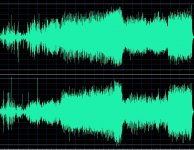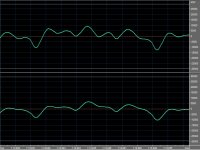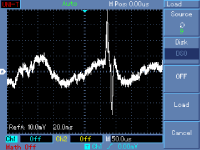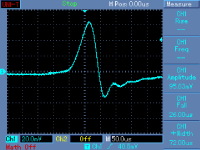Are those the 2 choices we get? Attenuated or exaggerated?
Pano as Ed would say maybe we just are not communicating. Maybe a picture would help. This is a rip from a fairly good DMM German pressing (whole side) with maybe 2 pops in the beginning of the lower (right) channel that went off scale. The rest of the surface noise, small ticks, crackle, etc. are linearly reproduced. The two pops might have gone to 2 or 3X full scale and driven the pre-amp or PA to the rails, I don't see clipping them with <10's of microseconds of recovery hurts the sound. I liken this to the one or two bad samples on a very scratched CD. These are stretched of course but by the simple size of the debris lodged in the groove.
Attachments
Last edited:
What's the time scale on that x axis?
Does the second figure help, the first is the whole 20min? The second is the first pop at ~1:14.
Just for fun this is the pop fixed with the free ClickFix plugin for Audition/CoolEdit. I do think it is cool, notice no thump which virtually all spectraly based tools leave.
Attachments
Last edited:
Noob alert :In the digital domain one could do content recognition through dynamic, harmonic and rhythmic analysis and simply disallow anything that's random and out of time with the music.
The control over signal in digital format is amazing. I am electronically illiterate but a digital filter for Phono would be great; which would have transient click pop removal, rumble noise removal, out of phase low frequency noise removal. One can always bypass it for direct turntable to analogue preamplifier.
Regards.
Scott,
11 Myths About Analog Noise Analysis | Analog content from Electronic Design
In the second item I am just not seeing how he gets his noise numbers. Any light would be appreciated.
I.E. 300e-9 x sqrt(50,000) x K = 9.7e-6 sort of (K=1.45!)
39e-9 x sqrt(1000) x Ke-3 = 8.7e-6 ??
4e-9 x sqrt(3e6) x K = 8.7e-6 (K=1.16!)
K is rolloff vs brickwall correction.
ES
11 Myths About Analog Noise Analysis | Analog content from Electronic Design
In the second item I am just not seeing how he gets his noise numbers. Any light would be appreciated.
I.E. 300e-9 x sqrt(50,000) x K = 9.7e-6 sort of (K=1.45!)
39e-9 x sqrt(1000) x Ke-3 = 8.7e-6 ??
4e-9 x sqrt(3e6) x K = 8.7e-6 (K=1.16!)
K is rolloff vs brickwall correction.
ES
Does the second figure help, the first is the whole 20min? The second is the first pop at ~1:14.
... and the dots are the actual sample values?
Jan
Thanks Scott and PMA. I've done some sampling of LP surface noise, too - but I was never sure how much the recordings were being BW limited by the circuits in front of the ADC.
For what it is worth a unit impulse should have an infinite rise time and thus due to the RIAA playback curve be attenuated infinitely!
I practice there is about 30 dB of attenuation re 1,000 hertz for the scratches, the last time I looked at that almost 40 years ago.
In the digital signal processing, the give away the the signal is caused by dirt or a scratch is the fall time. Musical notes decay, impulse noise falls off without decay. The first generation of noise reduction merely muted the signal when it detected an error. This required a slight delay of the signal. Later versions would interpolate the level. The best versions will do a good job of synthesizing the missing information based on the recent spectrum history and look forward.
The first effective restoration systems were analog and the record was played backwards so any signal with a fast rise time was muted!
I practice there is about 30 dB of attenuation re 1,000 hertz for the scratches, the last time I looked at that almost 40 years ago.
In the digital signal processing, the give away the the signal is caused by dirt or a scratch is the fall time. Musical notes decay, impulse noise falls off without decay. The first generation of noise reduction merely muted the signal when it detected an error. This required a slight delay of the signal. Later versions would interpolate the level. The best versions will do a good job of synthesizing the missing information based on the recent spectrum history and look forward.
The first effective restoration systems were analog and the record was played backwards so any signal with a fast rise time was muted!
Thanks Scott and PMA. I've done some sampling of LP surface noise, too - but I was never sure how much the recordings were being BW limited by the circuits in front of the ADC.
Hi Pano,
I made the measurements with high speed digital oscilloscope (DSO), so no problems with BW limitations.
For what it is worth a unit impulse should have an infinite rise time and thus due to the RIAA playback curve be attenuated infinitely!
Small reminder, measurements (at least mine) made directly from cartridge output. Cartridge frequency response and resonance is the limiting factor of its output voltage speed. One cannot get infinitely short rise time at the cartridge output.
Just for fun this is the pop fixed with the free ClickFix plugin for Audition/CoolEdit. I do think it is cool, notice no thump which virtually all spectraly based tools leave.
Long time ago I did not have editing tools on a point by point basis, so I would just cut out the offensive double bump using a "scissor" the width of the base frequency inverted. If the base signal was 1 Khz, I would cut a millisecond out, essentially leaving the base waveform intact and continuous.
Typically, both channels would mend equally well.
And the tic waveform was dependent on the cart impedance.
John
Small reminder, measurements (at least mine) made directly from cartridge output. Cartridge frequency response and resonance is the limiting factor of its output voltage speed. One cannot get infinitely short rise time at the cartridge output.
Pavel,
I am shocked to learn you cannot move a stylus and cantilever arm instantly! 🙂 Next I'll have to learn you can't get the infinite rise in any real electrical components with inductance, resistance and capacitance!
The fastest rise time cartridges were designed for "CD-4" records. (Compatible Discrete 4 Channel). These quadraphonic recordings required response up to 45,000 hertz.
So of course there is a limit to the slew rate of a record defect. That is why the RIAA curve only gives up to about 30 dB attenuation to the HF noise. (20 db at 20,000 hertz re midband.)
Yes, I saw that. Was there anything between the cart and the o-scope that might limit bandwidth, like an RIAA preamp?I made the measurements with high speed digital oscilloscope (DSO), so no problems with BW limitations.
Yes, I saw that. Was there anything between the cart and the o-scope that might limit bandwidth, like an RIAA preamp?
As already told, it was measured directly at cartridge output. You can also deduce it from Y axis amplitude.
For those who like a real time box Sweet Vinyl Launches SugarCube SC-1 Pop and Tick Remover | Analog Planet.
- Status
- Not open for further replies.
- Home
- Member Areas
- The Lounge
- John Curl's Blowtorch preamplifier part II




